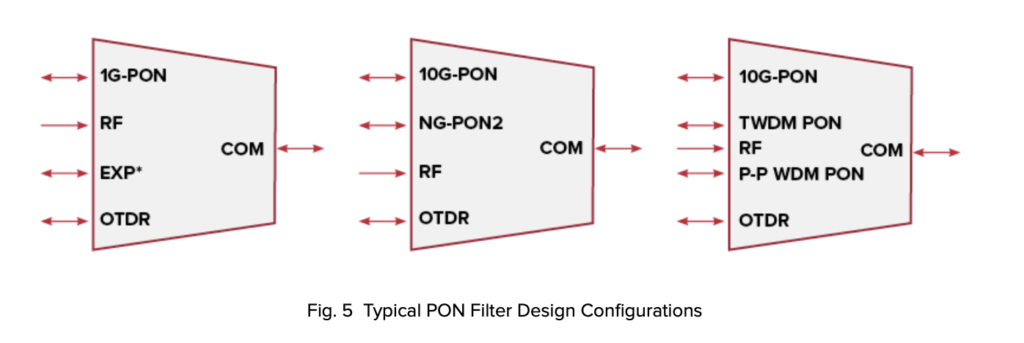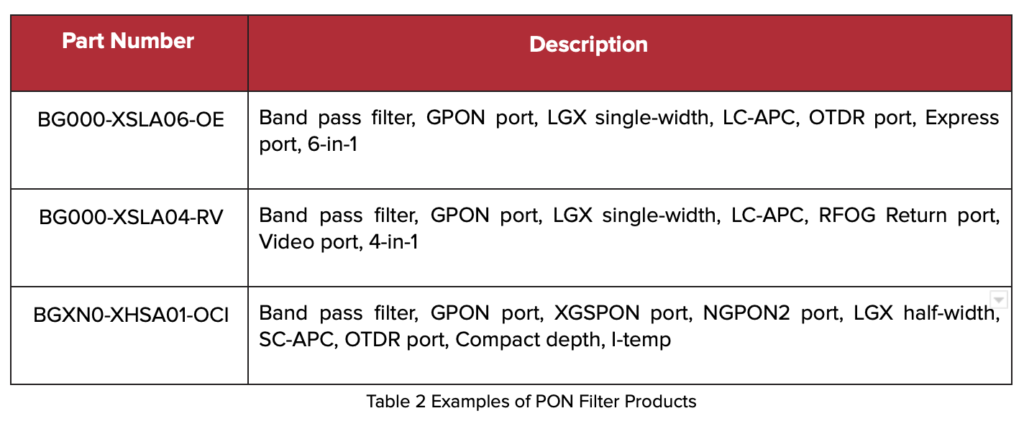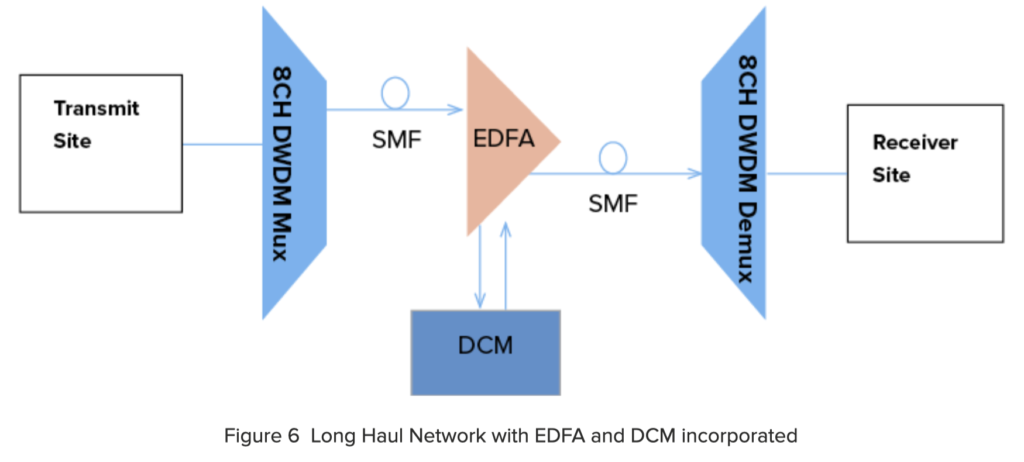
Mux/Demux: Passive, Yet Powerful

Mux/Demux, shorthand for the technique known as Multiplexing/Demultiplexing, is a keystone technology in modern communications networks. In this blog, we’ll discuss mux/demux applications for DWDM, CWDM and PON throughout various levels of the network.
Mux/Demux, Defined
An optical Mux/Demux is probably the simplest, most basic component in a wavelength division multiplexing (WDM) system. It is passive (unpowered) and generally uncooled. Yet it is an extremely powerful device in terms of how it has transformed communications networks to enable extensive amounts of information to be transported extremely long distances. Shown below in Figure 1a are two identical, bidirectional Mux/Demux devices which would be used as shown in Fig 1b to combine(multiplex) optical signals of various wavelengths for transmission through a single fiber, and then separate (demultiplex) the signal on the other end.
In our featured white paper, Leveraging DWDM Tunable Optics to Simplify Optical Access Deployments, we talked about how the use of multi-platform tunable transceivers in DWDM(Dense Wavelength Division Multiplexing) networks reduces both CapEX and OpEX by reducing sparing and other complexities in the field. Here we’ll look at Mux/Demux applications ranging from access networks to long haul/ultra-long haul along and some of the technology/products employed in each.
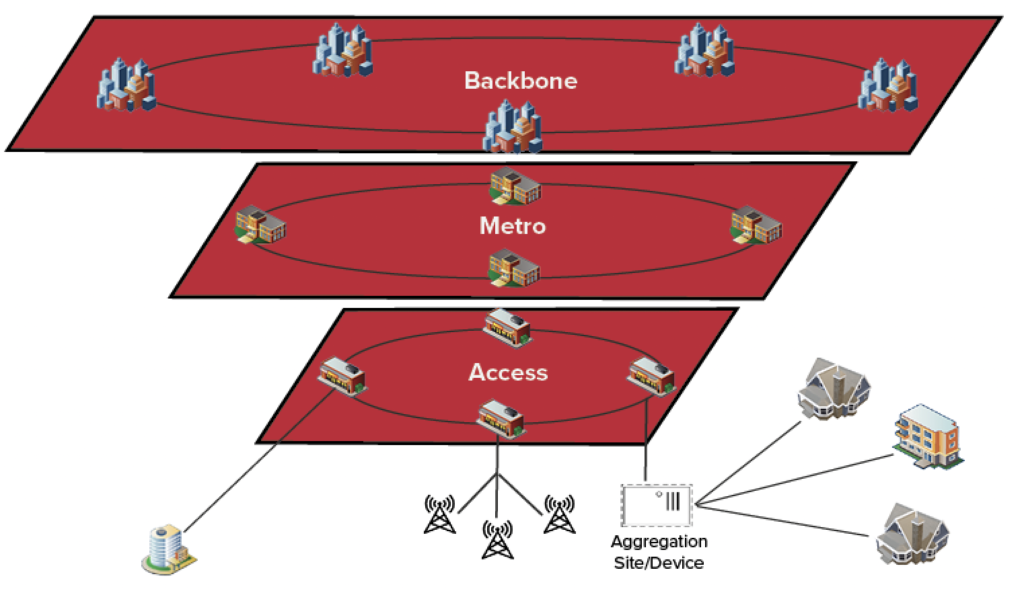
Figure 2 shows an overview of a communications network highlighting three major parts: Access, Metro and Long Haul (aka Backbone). Mux/Demux may be employed in any/all of these stages to aggregate data from multiple sources into one fiber so it can more easily be transported and disseminated on the other side. Think of “rural roads” near the outer portions of the network feeding into “interstate” communications traffic in the core(backbone) of the network. Only on the multiplexed highway, “commuting wavelengths” can essentially be piled on top of one another without interfering or disrupting transport. That’s the power of Mux/Demux. By employing multiplexing/demultiplexing technology, up to 96 channels of traffic can be combined and transported together over the same fiber. Below we’ll discuss applications for DWDM, CWDM(Coarse WDM) and also PON (Passive Optical Network) in various levels of the network.
Access
Access Networks are known as “the edge”. This is where data is transferred back and forth from, for example, individual users at residences, on cell phones or at desks in large office buildings. All of that data is aggregated at collection points as shown in the Access overview in Figure 1. Figure 2 below shows a more detailed example of the various technologies and complexities of information that may feed into an Access network. Everything from 5G cell networks, 10G RPD(Remote Phy devices), standard radio transmissions, and various individual wavelength services may be collected and disseminated at the Access network level.
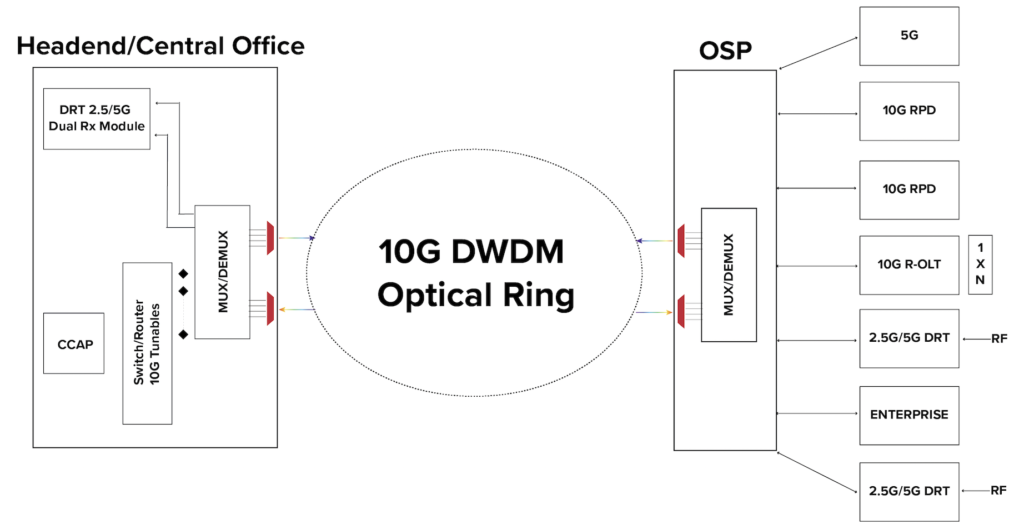
PON, CWDM and DWDM may all be used in the Access space. Typically, a good rule of thumb is to use CWDM (Coarse WDM) for shorter distances & fewer channels and DWDM for longer distances and more channels. PON architecture is ideal for home internet, voice and video applications. Determining the optimum network design and how to best utilize Mux/Demux filters involves several factors and requires a thorough understanding of your network environment and system requirements. It’s best to work with experienced network system experts to help address bandwidth needs and fiber scarcity in the most effective and efficient manner possible.
A CWDM system commonly supports eight wavelengths for 10G data rate networks and is not generally suited for fiber spans longer than 80km due to optical amplifier constraints in the CWDM wavelength spectrum. The limitations of CWDM, along with the ravenous pace at which bandwidth appetites are growing in the Access space, is finding DWDM favorable to legacy CWDM solutions. DWDM provides a scalable, multi-channel solution, commonly supporting 40 to 48 wavelengths on a single fiber using 100 GHz spacing. A few sample products are shown in Table 1 below.
PON
Due to its unique nature as a point-to-multipoint (P2MP) architecture, PON has the ability to reach nearly any user, even in previously isolated and remote areas where fiber optics are now enabling internet access. According to Light Reading, “The pandemic accelerated the adoption of next-gen PON. Next-gen PON OLT port shipments approached 830,000 in 2Q20, up 70% YoY. By 2025, the majority of GPON ONTs/ONUs will be 10G capable.”
Precision OT’s PON filters are essentially CEx (Coexistence) elements. These modules provide a single WDM device to combine legacy GPON services with emerging XGSPON and NGPON2 technologies. Additional optional wavelengths in a PON filter may include RFoG, OTDR monitoring, WDM as well as waves for additional current and future technologies.
Figure 5 shows a few examples of PON filters. Precision OT’s team of systems engineers and PON specialists are able to accommodate unique requirements for:
- configuration
- wavelength channel plans
- form factors and dimensions (LGX – Light Guide Cross Connect – is most common)
- connector types
- chassis designs
- indoor and outdoor cassettes
Metro, Long Haul/Ultra Long Haul
The term “Metro” applied to networks can mean various things. In general it’s the type of application that would fall somewhere between an Access/FTTH type network and a long haul application. Metro networks might include enterprise, point-to-point and active ethernet networks. It could also include service provider links across town, spans up to a couple hundred km, and 20 or 40 channel DWDM in a ring topology. In some situations it might include ROADMs (reconfigurable optical add-drop multiplexer) and amplifiers as needed. As you move more into longer distance networks (out of metro regional areas or cross country) you’ll start to see more and more of these latter components.
Mux/Demux has brought incredible efficiency and capability to the process of collecting and transmitting enormous amounts of data over long distances. DWDM in particular simplifies transmission and enables the use of amplification, such as the EDFA (Erbium Doped Fiber Amplifier) and also various types of error correction such as DCMs (Dispersion Compensation Modules) as shown in Figure 6 below.
Because of the long distance the light has to travel for Long Haul and Subsea applications, particular attention must be paid toward analyzing and accounting for chromatic dispersion and loss of signal-to-noise ratio in calculating a loss budget. In addition, every fiber, amplifier, optic and accessory component in the transport network must have ultra-high reliability and survivability. Long Haul and Ultra Long Haul carry enormous amounts of information. A link or node failure for even a few minutes can cause huge loss of data and hence extensive revenue loss for high value applications.
Conclusion
Designing and deploying networks that truly harness the power of Mux/Demux technology requires working with a partner who is more than just an optical filter provider. They also need to provide a wide array of quality multi-platform optics and network components and have the engineering expertise to design, analyze, test and validate the network from beginning to end. Precision OT has a successful track record of system an/or component deployments in all network levels from Access to Ultra Long Haul.
To learn more, contact the experts at Precision Optical Technologies or check out our Mux/Demux page.



